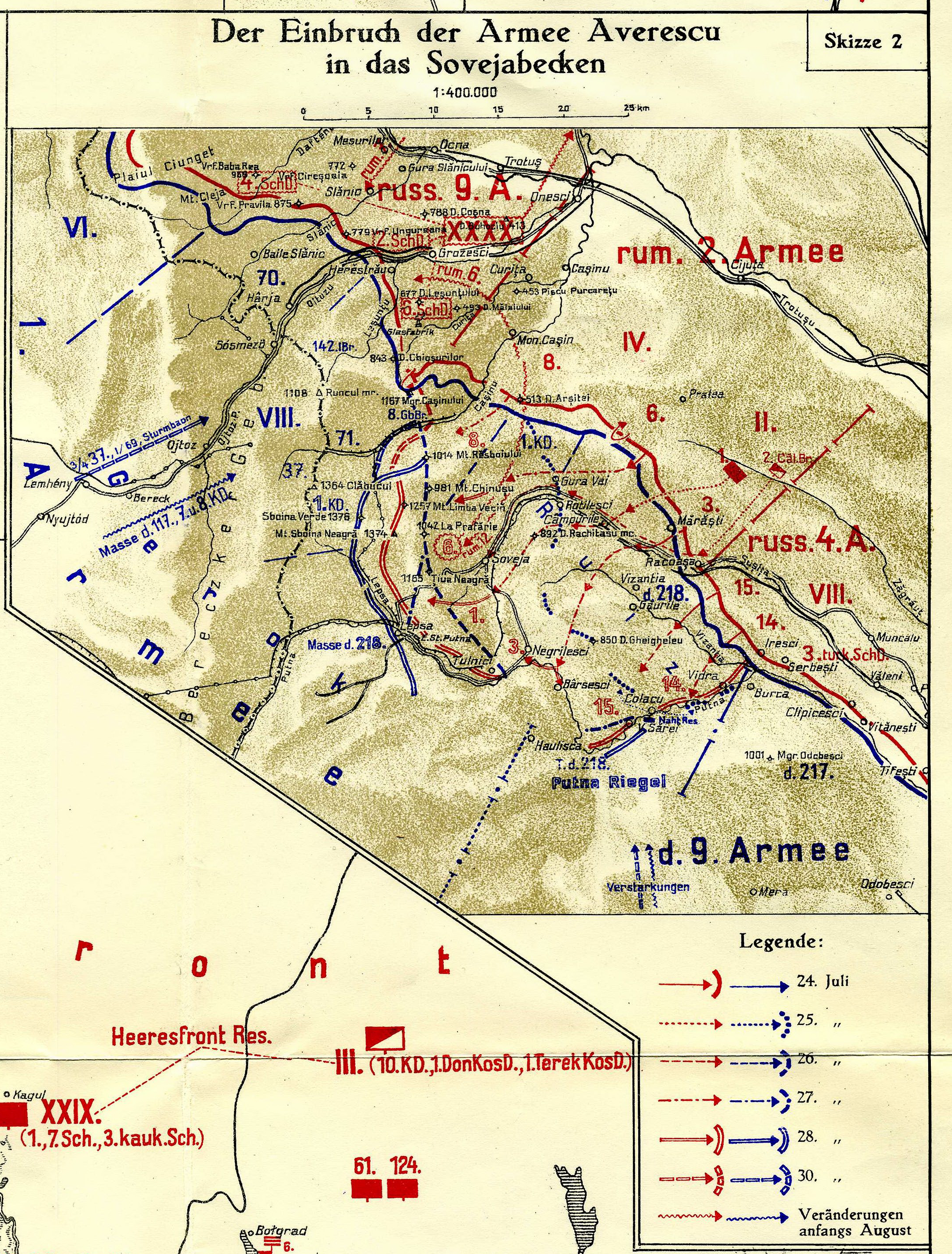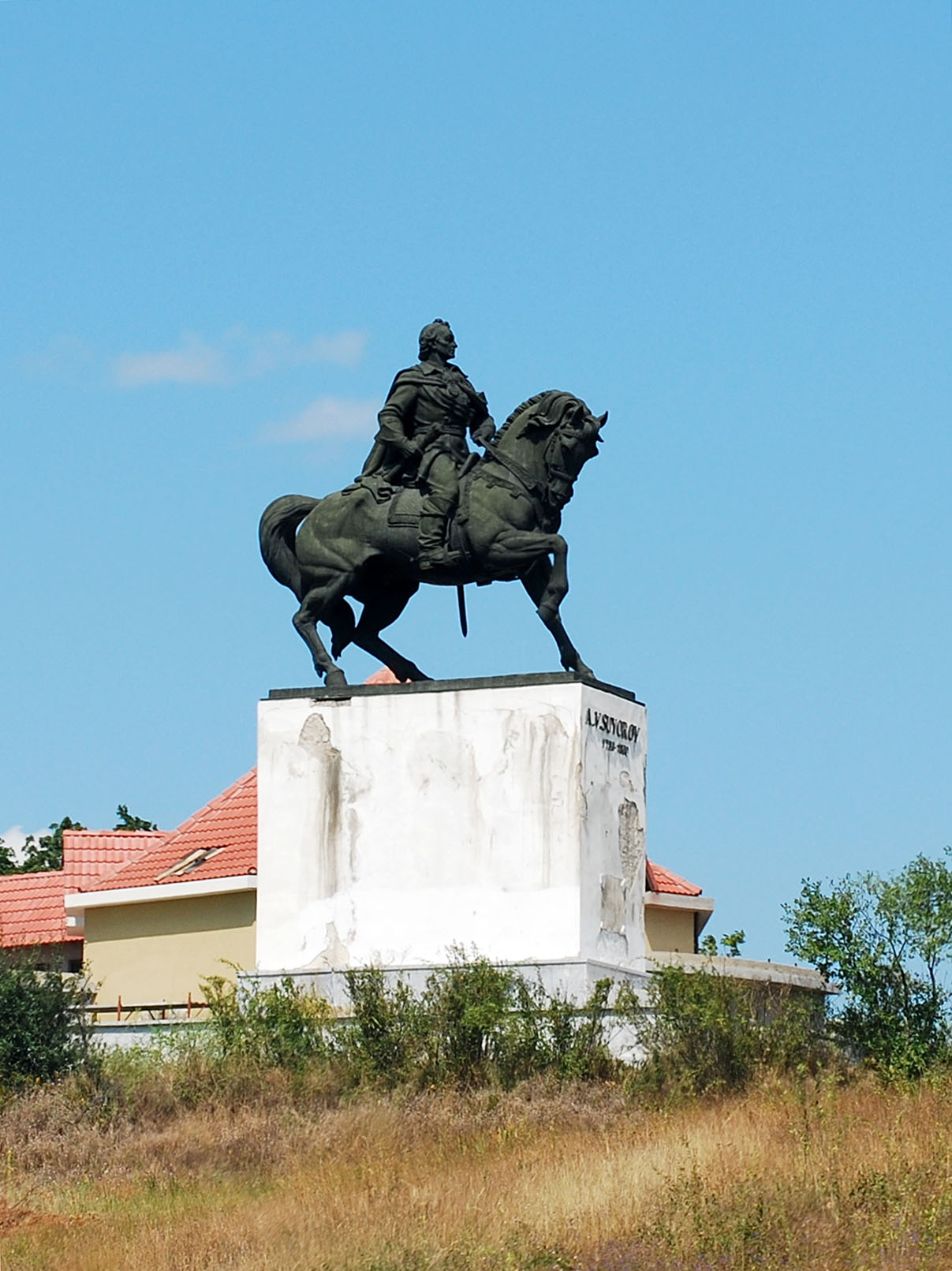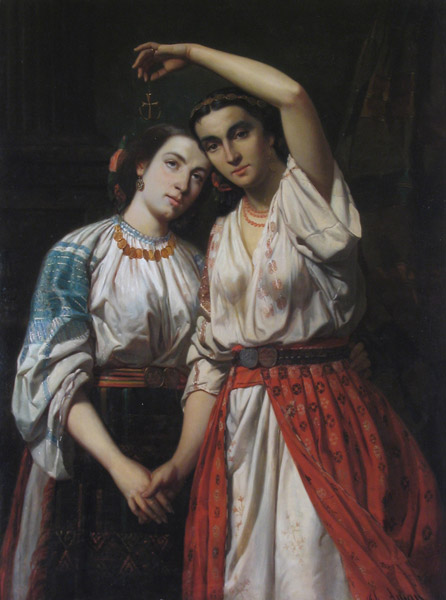|
Câmpuri
Câmpuri is a commune located in Vrancea County, Romania. It is composed of five villages: Câmpuri, Fetești, Gura Văii, Rotileștii Mari, and Rotileștii Mici. The commune is located in the northern part of the county, on the border with Bacău County. It lies on the banks of the river Șușița and its tributaries, Cremeneț and . Câmpuri is crossed by the national road which connects it to the west to Soveja and Tulnici and to the southeast to Răcoasa, Străoane, Panciu, and Mărășești (where it ends in DN2). The county capital, Focșani, is to the southeast via route . In July 1917, part of the Battle of Mărăști was fought in this area. Natives * Gina Gogean (born 1977), artistic gymnast *Ion Roată Ion Roată (; also known as Ioan Roată or Moș Ion Roată; 1806 in Câmpuri, Vrancea County – 20 February 1882 in Gura Văii) was a Moldavian, later Romanian peasant and political figure. Roată was representative in the Moldavian ad hoc Divan ... ... [...More Info...] [...Related Items...] OR: [Wikipedia] [Google] [Baidu] |
Ion Roată
Ion Roată (; also known as Ioan Roată or Moș Ion Roată; 1806 in Câmpuri, Vrancea County – 20 February 1882 in Gura Văii) was a Moldavian, later Romanian peasant and political figure. Roată was representative in the Moldavian ad hoc Divan for the peasant electoral college of Putna County. With ''Partida Naţională'', he supported the election of Alexandru Ioan Cuza as Prince of Moldavia, as well as endorsing his elections in Wallachia (leading to the union of the two Danubian Principalities, which eventually occurred on 24 January 1859). At the same time, he campaigned in favor of land reform in Moldavia and Romania at large. Roată was known for his personal friendship with ''Domnitor'' Cuza and his main supporter, Mihail Kogălniceanu; events involving the three of them are present in a series of anecdotes by Ion Creangă Ion Creangă (; also known as Nică al lui Ștefan a Petrei, Ion Torcălău and Ioan Ștefănescu; March 1, 1837 – December 31, 1889) was a M ... [...More Info...] [...Related Items...] OR: [Wikipedia] [Google] [Baidu] |
Battle Of Mărăști
The Battle of Mărăști ( ro, Bătălia de la Mărăști) was one of the main battles to take place on Romanian soil in World War I. It was fought between 22 July and 1 August 1917, and was an offensive operation of the Romanian and Russian armies intended to encircle and destroy the German 9th Army. The operation was planned to occur in tandem with the Nămoloasa offensive; however, this operation was abandoned before it began. Background Mărăști, just like Mărășești, is part of the strategically important Focșani Gate, the control of which eases attacks into several Romanian regions. The opposing forces At the beginning of July, based on the campaign plan drawn up in May by the High Command, final instructions were given to the 1st and 2nd Romanian Armies. The 1st Army was to carry out the principal attack around Nămoloasa and then, on terrain prepared by the latter, the 2nd Army, commanded by General Alexandru Averescu, was to carry out a second-order attack towar ... [...More Info...] [...Related Items...] OR: [Wikipedia] [Google] [Baidu] |
Cremeneț
The Cremeneț is a left tributary of the river Șușița in Romania Romania ( ; ro, România ) is a country located at the crossroads of Central Europe, Central, Eastern Europe, Eastern, and Southeast Europe, Southeastern Europe. It borders Bulgaria to the south, Ukraine to the north, Hungary to the west, S ....Ovidiu Gabor – , map page 10 It discharges into the Șușița in Rotileștii Mici. Its length is and its basin size is . References * Soare, Ionica Proiect Valea Șușiței Rivers of Romania Rivers of Vrancea County {{Vrancea-river-stub ... [...More Info...] [...Related Items...] OR: [Wikipedia] [Google] [Baidu] |
Vrancea County
Vrancea () is a county (județ) in Romania, with its seat at Focșani. It is mostly in the historical region of Moldavia but the southern part, below the Milcov River, is in Muntenia. Demographics In 2011, it had a population of 340,310 and a population density of . * Romanians – over 98% * Romani, others – 2% Geography Vrancea County's area is of . A curvedly shaped mountainous area, known in Romanian as the '' Carpații de Curbură'', lies in the western part of the county, at the Southern end of the Eastern Carpathians, with heights over . To the East, the heights decrease into hilly areas and the lower valley of the Siret River. The main tributary of the Siret, which crosses the county, is the Putna River. Seismic hazard The territory of Vrancea County is the most seismically active zone of Romania, with yearly earthquakes whose focal depths are between and therefore affect wide regions. The earthquakes with the epicenter in Vrancea are caused by the mo ... [...More Info...] [...Related Items...] OR: [Wikipedia] [Google] [Baidu] |
Gina Gogean
Gina Elena Gogean (born 9 September 1977) is a retired artistic gymnast from Romania who competed internationally in the late 1980s and throughout the 1990s. During her career she won an impressive number of 30 medals at Olympic Games, world championships or continental championships. Her best events were the floor exercise (three-time world champion), the vault (two-time world champion) and the balance beam (1997 world champion). She was also an excellent all around gymnast winning several medals on this event, the European title in 1994, a silver Olympic medal (1996) and a silver medal at the 1993 World Championships. She helped the Romanian team win three consecutive world titles (1994, 1995 and 1997) and two Olympic team medals, a silver and a bronze (1992 and 1996). Gogean was inducted into the International Gymnastics Hall of Fame in 2013. Criticized for her lack of artistry and expression, Gogean nonetheless had nearly unmatched consistency, longevity, and efficiency that m ... [...More Info...] [...Related Items...] OR: [Wikipedia] [Google] [Baidu] |
Șușița (Siret)
The Șușița is a right tributary of the river Siret in Romania.Ovidiu Gabor - , map page 10 It discharges into the Siret in Doaga. It flows through the following towns and villages, from source to mouth: Rucăreni, Dragosloveni, Rotileștii Mari, Câmpuri, Gogoiu, Răcoasa, Varnița, Repedea, Panciu, Satu Nou, Tișița and Doaga. Its length is and its basin size is . Tributaries The following rivers are tributaries to the river Șușița (from source to mouth): *Left: Dragomira, Soveja, Chiua, Dumicuș, Cremeneț, Alba, Verdea, Repejoara (or Pârâul Repede), Punga, Aluna ''Aluna'' is a 2012 feature-length documentary film sequel to the 1990 BBC documentary '' From the Heart of The World: Elder Brother's Warning''. The first documentary showed an ancient Kogi tribe civilisation (the Elder Brother) who emerge ..., Ernatica, Gâsca (or Pârâul lui Gâscă), Pârâul lui Pricop, Repedea (or Valea Rea), Valea Îngustă, Volădanu, Hăulița *Right: Păcura, Fu ... [...More Info...] [...Related Items...] OR: [Wikipedia] [Google] [Baidu] |
Străoane
Străoane is a commune located in Vrancea County, Western Moldavia, Romania. It is composed of four villages: Muncelu, Repedea, Străoane, and Văleni. Natives * Gheorghe Alexianu (1897–1946), lawyer, governor of Transnistria between 1941 and 1944, convicted war criminal * Ion Ciocârlan Ion Ciocârlan (July 12, 1874–1942) was a Romanian prose writer. Born in Străoane, Vrancea County, he graduated from the normal school in Iași in 1895, becoming a schoolteacher. His published debut came in ''Sămănătorul'' in 1902, under ... (1874–1942), prose writer References Communes in Vrancea County Localities in Western Moldavia {{Vrancea-geo-stub ... [...More Info...] [...Related Items...] OR: [Wikipedia] [Google] [Baidu] |
Focșani
Focșani (; yi, פֿאָקשאַן, Fokshan) is the capital city of Vrancea County in Romania on the banks the river Milcov, in the historical region of Moldavia. It has a population () of 79,315. Geography Focșani lies at the foot of the Curvature Carpathians, at a point of convergence for tectonic geologic faults, which raises the risk of earthquakes in the vicinity. Though Vrancea County is one of the most popular wine-producing regions in Romania, Odobești being just to the northwest, in Romania, Focșani itself is not considered a wine-producing center. The wine sold as ''Weisse von Fokshan'' in Germany and some other European countries is generally a ''Fetească Albă de Odobești'' wine, and practically a second-rated wine which does not comply to the European Union rules of naming the regions of origin of wines. The vicinity is rich in minerals such as iron, copper, coal, and petroleum. The city administers two villages, Mândrești-Moldova and Mândrești-Munteni. ... [...More Info...] [...Related Items...] OR: [Wikipedia] [Google] [Baidu] |
Mărășești
Mărășești () is a small town in Vrancea County, Western Moldavia, Romania. It administers six villages: Călimănești, Haret, Modruzeni, Pădureni, Siretu and Tișița. Geography The town is located in the eastern part of the county, on the border with Galați County. It is north of the county seat, Focșani. Mărășești lies on the right bank of the river Siret, which separates it from Galați County, in the area where the Siret receives the waters of the rivers Șușița and Zăbrăuț. History King Milan I of Serbia was born in Mărășești on 22 August 1854. In 1917 during World War I, the Battle of Mărășești between the Kingdom of Romania and the German Empire was fought near the town. It was the last major battle between the German Empire and the Kingdom of Romania on the Romanian front during World War I. A mausoleum containing the remains of 5,073 Romanian soldiers was built to commemorate the Romanian victory. Maria Zaharia (1905–1917) was born in ... [...More Info...] [...Related Items...] OR: [Wikipedia] [Google] [Baidu] |
Panciu
Panciu () is a town in Vrancea County, Romania. It lies on the river Șușița, in the southern part of Western Moldavia, northwest of Focșani. It has a population of approximately 7,600. It administers five villages: Crucea de Jos, Crucea de Sus, Dumbrava, Neicu and Satu Nou. The town is located in the east-central part of the county, on the banks of the Șușița River. The region is famous for its white wines but also for its sparkling wine Sparkling wine is a wine with significant levels of carbon dioxide in it, making it fizzy. While the phrase commonly refers to champagne, European Union countries legally reserve that term for products exclusively produced in the Champagne regi ...s (white, red and rosé). Writer Ioan Slavici died in Panciu in 1926, and was buried at the hermitage within . Natives * Stelian Isac * Dan Nica References External links Panciu Town Hall Towns in Romania Populated places in Vrancea County Localities in Western Moldavia ... [...More Info...] [...Related Items...] OR: [Wikipedia] [Google] [Baidu] |
Tulnici
Tulnici is a commune in Vrancea County, Romania Romania ( ; ro, România ) is a country located at the crossroads of Central, Eastern, and Southeastern Europe. It borders Bulgaria to the south, Ukraine to the north, Hungary to the west, Serbia to the southwest, Moldova to the east, a ..., located in the northwestern part of the county. It is one of the largest administrative areas in Vrancea County, situated at an altitude of 480 m above sea level at the foothills of the Vrancea Mountains. The commune is composed of four villages: Coza, Greșu, Lepșa and Tulnici, extending over an area of 30,000 hectares. It also included two other villages until 2003, when these were split off to form Păulești Commune. Tulnici is attested around the year 1466. See also * Gălăciuc Notes Communes in Vrancea County Localities in Western Moldavia {{Vrancea-geo-stub ... [...More Info...] [...Related Items...] OR: [Wikipedia] [Google] [Baidu] |
Răcoasa
Răcoasa is a commune located in Vrancea County, Romania. It is composed of five villages: Gogoiu, Mărăști, Răcoasa, Varnița and Verdea. It is situated in the historical region of Western Moldavia. Mărăști village () was the site of the World War I Battle of Mărăști. Notable people * Aurel Iancu * Gheorghe Vlădescu-Răcoasa Gheorghe Vlădescu-Răcoasa (October 22, 1895–December 17, 1989) was a Romanian sociologist, journalist, left-wing politician, and diplomat. Biography Origins and work with Gusti Born in Răcoasa, Vrancea County, his parents were Constantin ... References Communes in Vrancea County Localities in Western Moldavia {{Vrancea-geo-stub ... [...More Info...] [...Related Items...] OR: [Wikipedia] [Google] [Baidu] |




